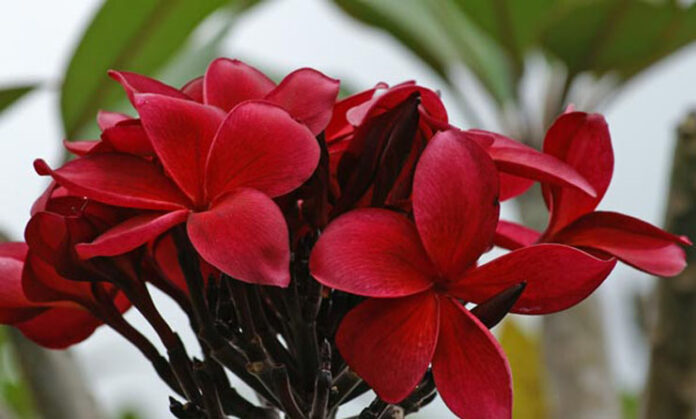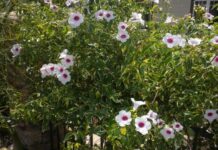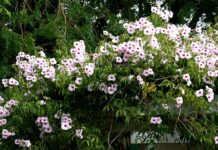
Hilo beauty plumeria belongs to the genus of flowering plants and includes mainly deciduous shrubs and small trees. It is native to Central America, Mexico and the Caribbean and South America to the south, Brazil but can be grown in the tropics and subtropics.
Hilo beauty plumeria – strong red/large, strong red center, petal wide, elliptical, round tip, slightly overlapping, moderate reddish-brown bands on front and back; heavy texture; 3 ½ to 4’’ via; scent slight spicy becoming stronger on storage; keeping quality as good as ‘Common Yellow’.
The flowers of this amazing plant are most fragrant at night in order to lure sphinx months to pollinate them. The flowers have no nectar, and simply dupe their pollinators. The months inadvertently pollinate them by transferring pollen from flower to flower in their fruitless search for nectar.
The genus, originally spelled Plumeria, a named in honor of the seventeenth – century French Botanic Charles Plumier, who travelled to the New World documenting many plant and animal species.
Origin: South America Florida
Cultivation difficulty: Moderate
Exhibition – Water – Soil – Fertilizer- Blossom- Proliferation
Hilo beauty plumeria can be easily propagated in the spring from the edges of the shoots without cuttings. The cuttings are allowed to dry at the base before planting in well-drained soils – cuttings are particularly sensitive to rot in moist soils. To make the most of a Hilo beauty plumeria plant in terms of growth, size, bloom and aroma, there is a delicate balance that must be maintained.
Ideally such a plant is in its element when it can have plenty of sun and the necessary water, so that the moisture of the contact is maintained just above the state of dryness. On the other hand, if the plant receives a smaller amount of sun, then a smaller amount of watering is necessary – again to ensure that soil moisture remains just above the dry state.
The more sun the more water. The less sun the less water. A common mistake of novice Hilo plumeria growers is to over-water when the plant is not able to be exposed to enough sun, thus leading it to a rotten root system. Conversely, if a Hilo Beauty Plumeria is able to receive maximum sun exposure but is not watered enough, then it will dry out.
Propagation can also be by culturing tissues from cuttings, recently elongated stems or by growing seeds under aseptic conditions. Pruning is best done in winter when cuttings are sought.
In Central America, beauty plumeria plant has a complex symbolic meaning for over 2000 years, with impressive specimens from the Mayan and Aztec periods to the present day. In local folklore, they provide refuge for ghosts and demons. The smell of Plumeria has been linked to a vampire in Malaysian folklore.
In both Hindu and Buddhist cultures, they are associated with temples. In many places they are used as common ornamental plants in houses, parks, parking lots etc such as in the Philippines.
Extra Info
- Flower strong red with large strong red centre.
- Petal elliptical, round tip, slightly overlapping; moderate reddish-brown bands on front and back heavy texture.
- Size three and one half to four inches in diameter.
- Scent slightly spicy, becoming stronger on storage.
- Stalk dark red, hairy, upright, tight flower clusters.
- Keeping quality as good as ‘Common Yellow’
- Plant habit upright, open branching; suitable for landscaping
- Bearing habit March to September, moderate flower production.
Plumeria flowers are most fragrant at night in order to lure sphinx moths to pollinate them. The flowers have no nectar, and simply dupe their pollinators. The moths inadvertently pollinate them by transferring pollen from flower to flower in their fruitless search for nectar.







![Rose Names And All Rose Types – The Most Detailed Guide [2022] rose names](https://www.yardious.com/wp-content/uploads/2018/05/rose-names-100x70.jpg)










